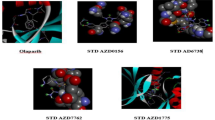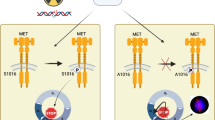Summary
Wortmannin is a potent inhibitor of phosphatidylinositol (PI) 3-kinase and PI 3-kinase-related proteins (e.g. ATM), but it does not inhibit the activity of purified calmodulin-dependent protein kinase II (CaMKII). In the present study, we compared the effects of wortmannin and the CaMKII inhibitor KN62 on the response of normal human dermal fibroblast cultures to γ radiation. We demonstrate that wortmannin confers a phenotype on normal fibroblasts remarkably similar to that characteristic of cells homozygous for the ATM mutation. Thus wortmannin-treated normal fibroblasts exhibit increased sensitivity to radiation-induced cell killing, lack of temporary block in transition from G1 to S phase following irradiation (i.e. impaired G1/S checkpoint), and radioresistant DNA synthesis (i.e. impaired S phase checkpoint). Wortmannin-treated cultures display a diminished capacity for radiation-induced up-regulation of p53 protein and expression of p21WAF1, a p53-regulated gene involved in cell cycle arrest at the G1/S border; the treated cultures also exhibit decreased capacity for enhancement of CaMKII activity post-irradiation, known to be necessary for triggering the S phase checkpoint. We further demonstrate that KN62 confers a radioresistant DNA synthesis phenotype on normal fibroblasts and moderately potentiates their sensitivity to killing by γ rays, without modulating G1/S checkpoint, p53 up-regulation and p21WAF1 expression following radiation exposure. We conclude that CaMKII is involved in the radiation responsive signalling pathway mediating S phase checkpoint but not in the p53-dependent pathway controlling G1/S checkpoint, and that a wortmannin-sensitive kinase functions upstream in both pathways.
Similar content being viewed by others
Article PDF
Change history
16 November 2011
This paper was modified 12 months after initial publication to switch to Creative Commons licence terms, as noted at publication
References
Banin, S, Moyal, L, Shieh, SY, Taya, Y, Anderson, CW, Cheesa, L, Smorodinsky, NI, Prives, C, Reiss, Y, Shiloh, Y & Ziv, Y (1998). Enhanced phosphorylation of p53 by ATM in response to DNA damage. Science 281: 1674–1677.
Beamish, H & Lavin, MF (1994). Radiosensitivity in ataxia-telangiectasia: anomalies in radiation-induced cell cycle delay. Int J Radiat Biol 65: 175–184.
Brugarolas, J, Chandrasekaran, C, Gordon, JI, Beach, D, Jacks, T & Hannon, GJ (1995). Radiation-induced cell cycle arrest compromised by p21 deficiency. Nature 377: 552–557.
Cliby, WA, Roberts, CJ, Cimprich, KA, Stringer, CM, Lamb, JR, Schreiber, SL & Friend, SH (1998). Overexpression of a kinase-inactive ATR protein causes sensitivity to DNA-damaging agents and defects in cell cycle checkpoints. EMBO J 17: 159–169.
El-Deiry, WS, Tokino, T, Velculescu, VE, Levy, DB, Parsons, R, Trent, JM, Lin, D, Mercer, WE, Kinzler, KW & Vogelstein, B (1993). WAF1, a potent mediator of p53 tumor suppressor. Cell 75: 817–825.
Hartley, KO, Gell, D, Smith, GCM, Zhang, H, Divecha, N, Connelly, MA, Admon, A, Lees-Miller, SP, Anderson, CW & Jackson, SP (1995). DNA-dependent protein kinase catalytic subunit: a relative of phosphatidylinositol 3-kinase and the ataxia telangiectasia gene product. Cell 82: 849–856.
Huang, H, Li, C-Y & Little, JB (1996). Abrogation of p53 function by transfection of HPV16 E6 gene does not enhance resistance of human tumour cells to ionizing radiation. Int J Radiat Biol 70: 151–160.
Jung, M, Zhang, Y, Lee, S & Dritschilo, A (1995). Correction of radiation sensitivity in ataxia telangiectasia cells by truncated IκB-α. Science 268: 1619–1621.
Kastan, MB, Zhan, Q, El-Deiry, WS, Carrier, F, Jacks, T, Walsh, WV, Plunkett, BS, Vogelstein, B & Fornace, Jr AJ (1992). A mammalian cell cycle checkpoint pathway utilizing p53 and GADD45 is defective in ataxia-telangiectasia. Cell 71: 587–597.
Khanna, KK & Lavin, MF (1993). Ionizing radiation and UV induction of p53 protein by different pathways in ataxia-telangiectasia cells. Oncogene 8: 3307–3312.
Komatsu, K, Yoshida, M & Okumura, Y (1993). Murine SCID cells complement ataxia-telangiectasia cells and show a normal post-irradiation response to DNA synthesis. Int J Radiat Biol 63: 725–730.
Lavin, MF (1993). Biochemical defects in ataxia-telangiectasia. In: Ataxia-telangiectasia. NATO ASI series H, RA Gatti, RB Painter (eds), Vol, 77, Springer-Verlag: Berlin, pp. 234–255.
Mayford, M, Wang, J, Kandel, ER & O’Dell, TJ (1995). CaMKII regulates the frequency-response function of hippocampal synapses for the production of both LTD and LTP. Cell 81: 891–904.
Meyn, MS (1995). Ataxia-telangiectasia and cellular responses to DNA damage. Cancer Res 55: 5991–6001.
Mirzayans, R, Smith, BP & Paterson, MC (1989). Hypersensitivity to cell killing and faulty repair of 1-β-D-arabinofuranosylcytosine-detectable sites in human (ataxia-telangiectasia) fibroblasts treated with 4-nitroquinoline 1-oxide. Cancer Res 49: 5523–5529.
Mirzayans, R, Famulski, KS, Enns, L, Fraser, M & Paterson, MC (1995a). Characterization of the signal transduction pathway mediating γ ray-induced inhibition of DNA synthesis in human cells: indirect evidence for involvement of calmodulin but not protein kinase C or p53. Oncogene 11: 1597–1605.
Mirzayans, R, Aubin, RA, Bosnich, W, Blattner, WA & Paterson, MC (1995b). Abnormal pattern of post-γ-ray DNA replication in radioresistant fibroblast strains from affected members of a cancer-prone family with Li–Fraumeni syndrome. Br J Cancer 71: 1221–1230.
Mirzayans, R, Enns, L & Paterson, MC (1997). Inhibition of DNA synthesis and G1/S-phase transition in normal human fibroblasts elicited by a heat-labile trans-acting factor in gamma-irradiated HeLa cell extracts. Radiat Res 147: 13–21.
Morgan, SE, Lovly, C, Pandita, TK, Shiloh, Y & Kastan, MB (1997). Fragments of ATM which have dominant-negative or complementary activity. Mol Cell Biol 17: 2020–2029.
Nagasawa, H, Li, Y, Maki, CG, Imrich, AC & Little, JB (1995). Relationship between radiation-induced G1 phase arrest and p53 function in human tumor cells. Cancer Res 55: 1842–1846.
Nakanishi, S, Kakita, S, Takahashi, I, Kawahara, K, Tsukuda, E, Sano, T, Yamada, K, Yoshida, M, Kase, H, Matsuda, Y, Hashimoto, Y & Nonomura, Y (1992). Wortmannin, a microbial product inhibitor of myosin light chain kinase. J Biol Chem 267: 2157–2163.
Olivier, M, Bautista, S, Valles, H & Theillet, C (1998). Relaxed cell-cycle arrest and propagation of unrepaired chromosomal damage in cancer cell lines with wild-type p53. Mol Carcinogenesis 23: 1–12.
Painter, RB (1986). Inhibition of mammalian cell DNA synthesis by ionizing radiation. Int J Radiat Biol 49: 771–781.
Palcic, B & Jaggi, B (1990). Image cytometry system for morphometric measurements of live cells. In: Bioinstrumentation: Research, Developments and Applications, DL Wise (ed), Butterworth: Stoneham, MA, pp. 923–991.
Powis, G, Bonjouklian, R, Berggren, MM, Gallegos, A, Abraham, R, Ashendel, C, Zalkow, L, Matter, WF, Dodge, J, Grindey, G & Vlahos, CJ (1994). Wortmannin, a potent and selective inhibitor of phosphatidylinositol-3-kinase. Cancer Res 54: 2419–2423.
Price, BD & Youmell, MB (1996). The phosphatidylinositol 3-kinase inhibitor wortmannin sensitizes murine fibroblasts and human tumor cells to radiation and blocks induction of p53 following DNA damage. Cancer Res 56: 246–250.
Rosenzweig, KE, Youmell, MB, Palayoor, ST & Price, BD (1997). Radiosensitization of human tumor cells by the phosphatidylinositol 3-kinase inhibitors wortmannin and LY294002 correlates with inhibition of DNA-dependent protein kinase and prolonged G2-M delay. Clin Cancer Res 3: 1149–1156.
Savitsky, K, Bar-Shira, A, Gilad, S, Rotman, G, Ziv, Y, Vanagaite, L, Tagle, DA, Smith, S, Uziel, T, Sfez, S, Ashkenazi, M, Pecker, I, Frydman, M, Harnik, R, Patanjali, SR, Simmons, A, Clines, GA, Sartiel, A, Gatti, RA, Chessa, L, Sanal, O, Lavin, MF, Jaspers, NGJ, Taylor, AMR, Arlett, CF, Miki, T, Weissman, SM, Lovett, M, Collins, FS & Shiloh, Y (1995). A single ataxia telangiectasia gene with a product similar to Pl-3 kinase. Science 268: 1749–1753.
Sedgwick, RP & Boder, E (1991). Ataxia-telangiectasia. Handb Clin Neurol 16: 347–423.
Shao, RG, Cao, CX, Shimizu, J, O’Conner, PM, Kohn, KW & Pommier, Y (1997). Abrogation of an S-phase checkpoint and potentiation of camptothecin cytotoxicity by 7-hydroxystaurosporine (UCN-01) in human cancer cell lines, possibly influenced by p53 function. Cancer Res 57: 4029–4035.
Taylor, AMR (1998). What has the cloning of the ATM gene told us about ataxia telangiectasia? Int J Radiat Biol 73: 365–371.
Tokumitsu, H, Chijiwa, T, Hagiwara, M, Mizutani, A, Terasawa, M & Hidika, H (1990). KN-62, 1-[N,O-Bis(5-isoquinolinesulfonyl)-N-methyl-L-tyrosyl]-4-phenylpiperazine, a specific inhibitor of Ca2+/calmodulin-dependent protein kinase II. J Biol Chem 265: 4315–4320.
Wang, Y & Iliakis, G (1992). Prolonged inhibition by X-rays of DNA synthesis in cells obtained by transfection of primary rat embryo fibroblasts with oncogenes H-ras and v-myc. Cancer Res 52: 508–514.
Young, BR & Painter, RB (1989). Radioresistant DNA synthesis and human genetic diseases. Hum Genet 82: 113–117.
Author information
Authors and Affiliations
Rights and permissions
From twelve months after its original publication, this work is licensed under the Creative Commons Attribution-NonCommercial-Share Alike 3.0 Unported License. To view a copy of this license, visit http://creativecommons.org/licenses/by-nc-sa/3.0/
About this article
Cite this article
Enns, L., Murray, D. & Mirzayans, R. Effects of the protein kinase inhibitors wortmannin and KN62 on cellular radiosensitivity and radiation-activated S phase and G1/S checkpoints in normal human fibroblasts. Br J Cancer 81, 959–965 (1999). https://doi.org/10.1038/sj.bjc.6690793
Received:
Revised:
Accepted:
Published:
Issue date:
DOI: https://doi.org/10.1038/sj.bjc.6690793
Keywords
This article is cited by
-
Enhanced induction of apoptosis in a radio-resistant bladder tumor cell line by combined treatments with X-rays and wortmannin
Radiation and Environmental Biophysics (2008)
-
Polyethyleneimine grafted with pluronic P85 enhances Ku86 antisense delivery and the ionizing radiation treatment efficacy in vivo
Gene Therapy (2004)
-
Metabolic labeling of human cells with tritiated nucleosides results in activation of the ATM-dependent p53 signaling pathway and acceleration of DNA repair
Oncogene (2003)
-
Cell adhesion to the extracellular matrix protein fibronectin modulates radiation-dependent G2 phase arrest involving integrin-linked kinase (ILK) and glycogen synthase kinase-3β (GSK-3β) in vitro
British Journal of Cancer (2003)
-
Aberrant sensing of extracellular Ca2+ by cultured ataxia telangiectasia fibroblasts
Oncogene (2003)



